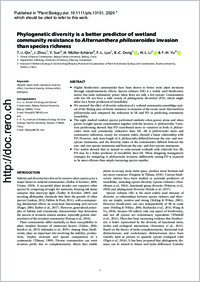Phylogenetic diversity is a better predictor of wetland community resistance to Alternanthera philoxeroides invasion than species richness
- Qin, Tian‐Jian School of Nature Conservation Beijing Forestry University Beijing 100083China
- Zhou, Jian School of Nature Conservation Beijing Forestry University Beijing 100083China
- Sun, Yan Department of Biology University of Fribourg CH‐1700Fribourg Switzerland
- Müller-Schärer, Heinz Department of Biology University of Fribourg CH‐1700Fribourg Switzerland
- Luo, Fang‐Li School of Nature Conservation Beijing Forestry University Beijing 100083China
- Dong, Bi‐Cheng School of Nature Conservation Beijing Forestry University Beijing 100083China
- Li, Hong‐Li School of Nature Conservation Beijing Forestry University Beijing 100083China
- Yu, Fei‐Hai Institute of Wetland Ecology & Clone Ecology Zhejiang Provincial Key Laboratory of Plant Evolutionary Ecology and Conservation Taizhou University Taizhou China
-
2020
Published in:
- Plant Biology. - 2020, vol. n, no. a, p. n
English
Highly biodiversity communities have been shown to better resist plant invasions through complementarity effects. Species richness (SR) is a widely used biodiversity metric but lacks explanatory power when there are only a few species. Communities with low SR can have a wide variety of phylogenetic diversities (PD), which might allow for a better prediction of invasibility. We assessed the effect of diversity reduction of a wetland community assemblage typical of the Beijing area on biotic resistance to invasion of the exotic weed Alternanthera philoxeroides and compared the reduction in SR and PD in predicting community invasibility. The eight studied resident species performed similarly when grown alone and when grown in eight-species communities together with the invasive A. philoxeroides. Variation partitioning showed that PD contributed more to variation in both A. philoxeroides traits and community indicators than SR. All A. philoxeroides traits and community indicators, except for evenness index, showed a linear relationship with PD. However, only stem length of A. philoxeroides differed between the one- and two-species treatments, and the diversity index of the communities differed between the one- and two-species treatments and between the one- and four-species treatments. Our results showed that in natural or semi-natural wetlands with relatively low SR, PD may be a better predictor of invasibility than SR. When designing management strategies for mitigating A. philoxeroides invasion, deliberately raising PD is expected to be more efficient than simply increasing species number.
- Faculty
- Faculté des sciences et de médecine
- Department
- Département de Biologie
- Language
-
- English
- Classification
- Biological sciences
- License
-
License undefined
- Identifiers
-
- RERO DOC 328400
- DOI 10.1111/plb.13101
- Persistent URL
- https://folia.unifr.ch/unifr/documents/308696
Other files
Statistics
Document views: 162
File downloads:
- pdf: 269
- Supplementary material: 170

